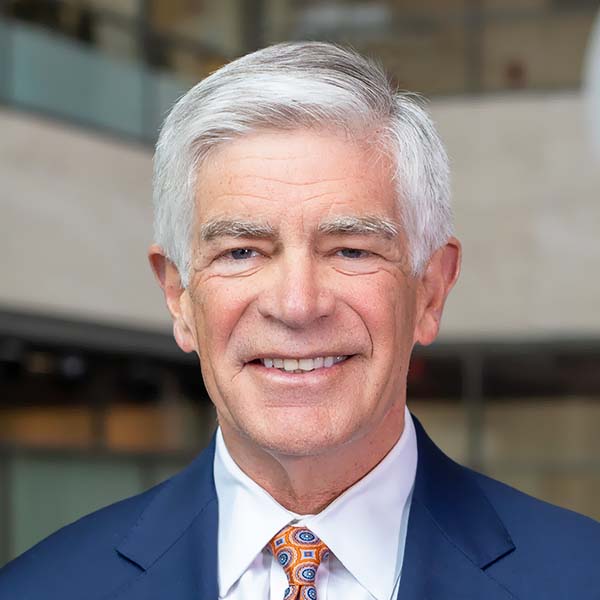Good morning from the East Coast of the United States. I know we’re joined by an international audience today, so good ... well, whatever time it happens to be wherever you are. On behalf of the Federal Reserve Bank of Philadelphia, I’m sincerely thrilled to welcome you all to this virtual conference.
The original plan was for me to greet you in person in our Bank in Philadelphia — instead I’m in the more cramped confines of my home office here in New Jersey. We’re still planning on having a full-scale conference in Philadelphia with our partners from the OMFIF around this time next year, which we’re all looking forward to. So, stay tuned for details on that.
Now, even though we’re meeting in strange circumstances today, many of the same old rules apply. Here is one of them: The views I express today are my own and do not necessarily reflect those of anyone else on the Federal Open Market Committee (FOMC) or in the Federal Reserve System.
We’ve gathered today to hear a distinguished panel provide what I’m sure will be a fascinating discussion on developments in artificial intelligence and machine learning. But before we get to that, I want to set the table by giving you a brief overview of where the economy has been and where it might be heading, recent actions by the Federal Reserve, and a few of my own considerations on machine learning.
The State of the Virus
All of these topics, of course, have been deeply affected by the same scourge that has kept us physically apart today: COVID-19.
So let’s begin, then, with where we are with the virus. As you well know, still less than a year after COVID-19 first emerged, the virus has infected more than 30 million people around the world and killed nearly 1 million.
The United States has been particularly hard hit. Because of our country’s unique inability to control the virus, we’ve suffered approximately 21 percent of the world’s deaths, despite housing only about 4 percent of the world’s population. Infection rates have come down from the highs we saw in the spring and summer, but the virus is still circulating widely in large swaths of the country.
And even within this disproportionately hard-hit country, certain communities have suffered more than others. Racial minorities, particularly African Americans and Hispanics, have been sickened from the coronavirus at a far higher rate than other groups. They have also died at a higher rate. And in the ensuing economic contraction, they have lost their jobs at a higher rate.
The State of the Economy
A virus as contagious, deadly, and frankly as mysterious as COVID-19 was bound to have a significant economic impact. Even before state and local governments took action this spring, many Americans had stopped dining out, getting on airplanes, and checking in to hotels. State and local governments then compounded the economic misery when — and I want to stress, in a responsible attempt to protect public health — they shuttered many businesses deemed nonessential.
The upshot? In the second quarter of this year, the U.S. suffered its worst quarterly GDP drop in recorded history when the economy contracted at an annualized rate of nearly 33 percent. Twenty-two million jobs evaporated. Those with low-wage jobs, particularly racial and ethnic minorities, were hardest hit.
The good news is, following that contraction, the economy has rebounded faster than many of us had projected. Stay-at-home orders have been lifted, and though large segments of the economy remain depressed, millions of Americans have returned to their jobs. Indeed, about half of those 22 million residents who were suddenly out of work earlier this year are now back, enough to nudge the unemployment rate down from 10.2 percent to a still-catastrophic 8.4 percent.
For now, I expect this recovery to continue, though not fast enough that, by the end of this year, GDP will have returned to where it was before the pandemic struck. That will take more time. And segments like tourism and hospitality will remain subdued for a long time to come, presenting an overall drag on GDP and employment growth. Employment, unfortunately, probably won’t be back to pre-pandemic levels until 2023.
I want to caution that this forecast is freighted with uncertainty because, once again, of COVID-19. The scenario of continued growth that I have presented depends on a sustained decline in the rate of new infections — probably a result of nearly universal mask-wearing, especially indoors — that ensures only sporadic new outbreaks. We’re also assuming that a vaccine becomes widely available sometime mid to late next year. But COVID-19, as the world has learned all too painfully, is difficult to control. And so the path of the economy largely depends on the path of the virus.
It depends in no small part, too, on the path that the federal government chooses to take. When COVID-19 first struck, it brought forth a policy response that, in my view, was commensurate to its gravity. Early on, Congress provided significant fiscal support for the economy through the CARES Act. That blunted the pain of the contraction. Unfortunately, that relief has now expired, and I would urge lawmakers to consider providing additional support soon.
The Role of the Fed
For our part, the Federal Reserve’s role in responding to the crisis has been robust. But our main power is lending. We cannot simply spend money or issue grants. That is Congress’s role.
The Fed’s role in mitigating this crisis has been to use those lending powers to maintain our underlying economic infrastructure by making sure that every sector of the economy has access to liquidity. Moreover, our lending facilities are meant as backstops to the private sector. We don’t want to disintermediate the private sector — we simply want to be there to support market functioning.
So, what have we done?
First and foremost, we lowered our policy interest rate to near zero fast and early. We kept this stance unchanged at this month’s FOMC meeting and indicated that we plan to keep those rates very low for a very long time.
In August, we also announced a long-considered change to how we will balance inflation and employment going forward. Following a nearly two-year review, the Fed announced we will no longer head off higher inflation by preemptively raising interest rates. Moreover, after long periods of sub-2 percent inflation — as we now find ourselves in — we will accept periods of above-2 percent inflation. Tolerating the risk of slightly higher inflation, in our view, is worth it if it helps us achieve our employment goals.
Using the discount window, we are also actively encouraging banks to borrow money from the Fed at ultralow interest rates, to make sure they have the funds they need to serve their customers at this critical time.
In order to keep markets functioning, beginning in March, we started buying large amounts of Treasury bonds and mortgage-backed securities. We have now purchased more than $2 trillion of these products. The markets have largely stabilized, and we’ve slowed the rate of purchases. As a backstop, we have also purchased some corporate debt, and as the economy and credit markets heal, we will disengage from that market as prudently and as expeditiously as possible.
Backed by credit protection from the U.S. Treasury, we’ve also launched the Main Street Lending Program, which provides support for small and midsize businesses that were in good financial standing before the COVID-19 pandemic. The program was recently expanded to include nonprofit organizations, such as universities and nonprofit medical institutions, which tend to be very important anchor institutions in their communities.
There has been somewhat limited interest in Main Street — only about 400 banks have registered to participate in this program. But in a way, that’s actually a good sign for the economy because it means that firms have access to capital without having to use the Fed. Because if you recall, in all of this, we are simply a backstop. On the other hand, if there is another major downturn in the economy, these facilities will still be in place to offer funding.
We’re also bolstering the Small Business Administration’s Paycheck Protection Program (PPP) by supplying liquidity to financial institutions that are issuing loans to those businesses that are receiving aid through the program.
PPP is now closed to new applications. But when it was open, it drew a lot of interest. More than 5 million loans were issued to the tune of more than $520 billion. Under our program, the Fed provided liquidity to institutions issuing about 17 percent of those loans. This is another positive sign for the economy and the financial sector, as it shows the vast majority of banks have sufficient liquidity to extend credit.
We’ve also rolled out a program to help cash-strapped local governments. The Municipal Liquidity Facility, whereby we buy bonds from municipalities and states whose tax revenues have collapsed, is designed to provide essential liquidity as they navigate the twin crises of the pandemic and the economic downturn. The State of Illinois has already tapped this, and we are also opening it to multistate agencies like the Port Authority of New York and other transit authorities. While so far only the State of Illinois has tapped this facility, the Fed by merely announcing its existence did a lot of work in getting private markets functioning again.
Machine Learning
COVID-19 has affected everything from health care to tax receipts to tourism. And so, of course, it has also had an impact on the subject of today’s panel discussion: artificial intelligence and machine learning.
Algorithms are built on precedent, and so it’s little surprise that as COVID-19 caught governments unawares, it also significantly affected the artificial intelligence that is increasingly used to power large segments of our economy. The algorithms — like all of us — had simply never experienced the set of circumstances that COVID-19 presented. And so many algorithms have seen a deterioration in their performance during this period.
Take credit scores. One would assume that in a time when 22 million Americans had lost their jobs and millions more Americans had their hours cut that credit scores would have declined. But in fact, the opposite happened: Credit scores have, in the aggregate, risen during this period.
One reason for this is that even in this economic downturn, delinquencies are actually down because the aforementioned CARES Act mandated loan forbearance. That was absolutely the right thing to do but led the currently used algorithms to the counterintuitive conclusion that default probabilities have in fact decreased.
Another consideration going forward will be to ensure that algorithms do not serve to perpetuate the kinds of discrimination that we have seen historically in our financial sector. Will machine learning perpetuate long-standing inequities in, for instance, the rate at which certain racial groups are turned down for loans?
This issue will require a conversation spanning academic fields — computer science, law, economics, and others. And it will also require action from not just regulators but probably lawmakers, too, given that many of the laws governing discrimination date back to 1961, when computers couldn’t even fit inside a single room. Conversations like the one we are hosting today hold important implications for the future of our economy — and making sure that we are building an equitable future for all of us.
And in the meantime, we can be rest assured the development of artificial intelligence and machine learning will continue — though I hope it stops before they figure out a way to replace Fed presidents with robots.
Thank you very much.
- The views expressed here are the speaker’s own and do not necessarily reflect those of anyone else in the Federal Reserve System.

